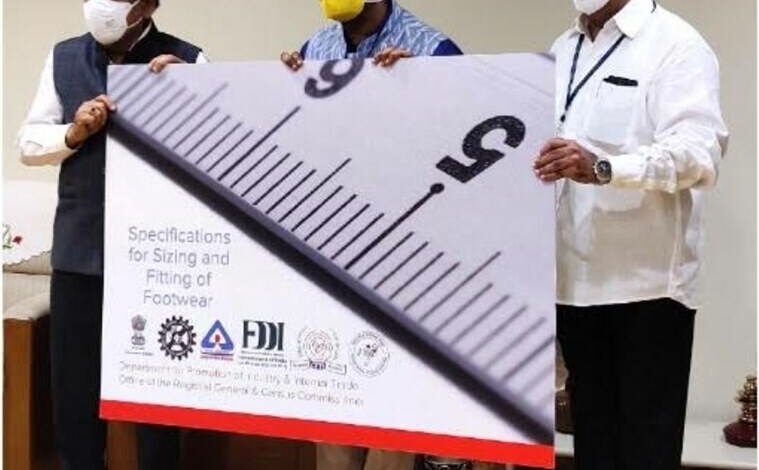You may have to share your foot size and characteristics as India conducts a “pan India feet scanning survey” for building its own Footwear Sizing System

A new thing to add to your interest is the new “pan India feet scanning survey” which shall be led by the CSIR-Central Leather Research Institute, abbreviated as CLRI. The data which will be collected from this new survey results will be put to use in defining Indian footwear size standards. These new Indian standards will be included in the size charts of shoe manufacturers. Well, another “feet” (feat) for Aatmanirbhar Bharat. Let’s dig deeper to find out what shoe-size system is being followed by Indian shoe manufacturers right now and what new will this survey brings to the table.
Hopefully, the introduction of this new uniform and standardized system of foot sizing will remove some of the ambiguity and confusion involved in buying shoes of ‘The US’, ‘EU’, or ‘UK’ sizes. The confusion reached paramount levels especially in the case of online transactions. The launch of the Footwear Sizing System of India has been done by the Union Minister for Health and Family Welfare, Dr Harsh Vardhan.
How big is India’s footwear industry?
Currently, the footwear industry in India includes four main schemes –American, English (UK), French (European), and Mondopoint (Japanese).
China is the largest footwear manufacturer followed by India. Being the second-largest footwear manufacturing country, India produces nearly 2,257 million pairs annually, also recording sales of nearly 2,021 million pairs every year. Interestingly, even though the manufacturing is done for all kinds of footwear, the share of men in the footwear industry is the largest ( 58 per cent approx.) while the share of women’s footwear is nearly 30 per cent. The remaining is distributed between the children’s footwear (9 per cent), and others (3 per cent)
What footwear sizing system does India follow?
Technically, India has never had its own original system to map the sizes of footwear and still follows the system of English sized introduced by the British before Independence. Even today, the shoe manufacturers in the Indian subcontinent manufacture footwear according to the English system. They also have size charts that mention the same in European and American scales as well.
Currently, in the foot-size system given by the United Kingdom in which the average Indian woman wears footwear sizes ranging between 4 to 6 while the average man’s footwear size ranges between 5 to 11. However, with this survey in talks, India could have its own ‘Footwear Sizing System’ by next year.
But, why is there a need to establish an Indian sizing system?
The process of manufacturing and designing footwear is quite intricate and complex and requires scientific and engineering expertise which need exact dimensions and scales. In order to design the product with an optimal comfort level along with assured foot health, these designers and creators need to have apt knowledge of the footwear sized. Needless to say, bad fits can cause injuries and pose to be a problem more so in those above age 40, women, as well as people who are diabetic.
Moreover, a footwear design based on a borrowed sizing system not unique to India might not be good both for the producer as well as the user. It may not always suit the requirements of the Indian wearer simply because the characteristics of Indian feet are different from that of European or American feet.
It was in 1969 when the Bureau of Indian Standards or BIS notified the Indian Standard Specification of Footwear in terms of sizes and fitting (IS 1638-1969). BIS is responsible to lay down standards and to certify product quality. It has been a long time since the same has been revised and obviously, the characteristics of Indian feet have become different since.
Furthermore, it is only in recent years that shoes have enjoyed much more popularity. Shoes have become a commodity of daily use and are more important to people now than ever before. Since 2015, the demand for footwear in the country has significantly and considerably increased.
As quoted by Dr K J Sreeram, director, CSIR-CLRI, Today Indians own 1.5 pairs per person on average in comparison to 0.5 to 0.6 pairs per person many decades ago. On the same lines, Md Sadiq, chief scientist at CSIR-CLRI, said: “The time has come to educate Indian consumers not only about footwear sizes, but also about right fits and comfort for good health.”
Are there any challenges that we can face while devising our own footwear sizing system?
Well, there are challenges to everything, aren’t there? But this time the biggest challenge lies in the vastness and regional variations of the country which might make it difficult to standardise the footwear sizes. The differences in characters of people within India will also make it difficult for the authorities to come up with a uniform code. These variations can be highlighted with the common observation that the people from the Northeast have smaller feet in comparison to the rest of the Indians. Moreover, the overall feet of Indians, in general, are broader near the toes, so a lot of people actually prefer a size bigger than actually required.
What is the CSIR-CLRI Footwear Sizing System project?
The CSIR-Central Leather Research Institute will first organize a first-of-its-kind anthropometric survey across the nation. The CSIR- CLRI footwear sizing project is scheduled to begin in the second of this year and will most probably go on for as many as 14 months. The entire project supported by the Department for Promotion of Industry and Internal Trade. The DPIIT comes under the Union Ministry of Commerce headed by minister Piyush Goyal.
What data will be collected in the survey?
All the data related to footwear designing will be collected under this project. All the collected stats will later be used to design a footwear sizing scheme that is unique to Indian requirements. The new system will also take into account the ethnic differences if any, and evaluate the characteristics and demographics (age and size) of the groups with special requirements. Then, a size range for the Indian population will be designed which would include an exhaustive numerical database highlighting the specific length and width of each group observed. This survey would involve conducting 3D foot scans and measuring the feet of every person surveyed.
How will the survey be done?
The teams conducting the survey will travel to pre-identified offices, groups of households, schools, CSIR labs, and defence institutions. According to Dr Sreeram, the survey teams will most probably use the network established by ASHA workers to identify every selected survey participant.
The survey is estimated to cost an enormous amount estimated around Rs 11 crore. The process will undertake 94 districts around Coimbatore, Chennai, Agra, Ahmedabad, Kolkata, Mumbai, Patna, Jodhpur, Jorhat, Jalandhar, Kanpur, and Shillong. Around 1,05,000 samples will be collected by the survey conductors using the 3D feet scanner machines. As many as 30 of these 3D feet scanner machines will be imported from Italy. The survey is set to take place from the month of June.
Currently, the CLRI is training its own staff as well as people from collaborating institutions to carry out the survey requirements. The collaborating institutions include the Footwear Design and Development Institute (FDDI), the National Institute of Fashion Technology (NIFT), and the Central Footwear Training Institute (CFTI).
Dr Harsh Vardhan, Union Minister for Health and Science and Technology, is the first subject in the country who presented his feet sample in January when the scheme was commenced. According to various sources, the scanner is able to capture about 30 dimensions within just 10 seconds. These dimensions include length and width measurements of foot regions and the arc angle.
How will the sizing scheme affect the show producers and users once it comes into effect?
It is expected that the sizing scheme will be ready by early 2022.
After the new scheme is implemented, the manufacturers of footwear would have to prepare shoe lasts in accordance with the Indian sizing system. By shoe lasts we mean the moulds or casts for footwear used by the designers.
The authorities would also have to provide a chart indicating the relationship or equivalents measurements among the Indian and international sizing schemes. And with this in place, not only the domestic manufacturer but also the international manufacturers (who wish to sell their products in the Indian markets) will have to design their shoes in line with the Indian sizing requirements.




